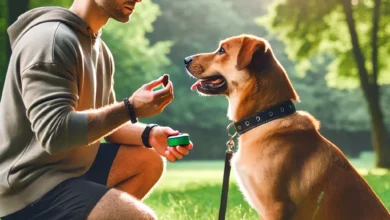Training Your Dog: A Comprehensive Guide to Obedience Training

Training your dog is one of the most rewarding experiences for both you and your furry companion. Obedience training lays the foundation for a healthy and enjoyable relationship, ensuring your dog is well-behaved, confident, and safe in various situations. This article explores everything you need to know about dog obedience training, including tips, techniques, and benefits.
Why Obedience Training Is Essential
Building a Strong Bond
Obedience training is not just about teaching your dog commands; it strengthens the bond between you and your pet. The process fosters trust and mutual respect, making your relationship more harmonious.
Ensuring Safety
Training ensures that your dog responds to essential commands such as “sit,” “stay,” and “come.” This responsiveness is crucial in preventing accidents, especially in dangerous situations.
Preventing Behavioral Issues
A well-trained dog is less likely to develop behavioral problems like excessive barking, chewing, or aggression. Obedience training provides mental stimulation and structure, reducing the likelihood of destructive behaviors.
Getting Started with Dog Obedience Training
Choose the Right Training Approach
There are various training methods, and it’s important to choose one that suits both you and your dog. Popular approaches include:
- Positive Reinforcement: Rewarding desired behaviors with treats, praise, or toys.
- Clicker Training: Using a clicker to mark correct behavior, followed by a reward.
- Model-Rival Training: Demonstrating desired behaviors through another dog or person as an example.
Start Early
The ideal time to begin obedience training is when your dog is a puppy, around 8 to 16 weeks old. However, older dogs can also learn with consistent effort and patience.
Create a Conducive Environment
Choose a quiet, distraction-free environment for training sessions. Gradually introduce distractions as your dog becomes more confident with commands.
Basic Commands Every Dog Should Know
Sit
Teaching your dog to sit is a fundamental command that establishes control in various situations.
Steps:
- Hold a treat close to your dog’s nose.
- Move your hand upward, allowing your dog’s head to follow the treat and causing their bottom to lower.
- Once they sit, say “sit” and reward them with the treat and praise.
Stay
The “stay” command teaches your dog patience and helps prevent unwanted movements.
Steps:
- Start with your dog in a sitting position.
- Hold your palm out and say “stay.”
- Take a step back, then return and reward them if they stay.
- Gradually increase the distance and duration of the stay.
Come
This command is essential for ensuring your dog’s safety, especially outdoors.
Steps:
- Attach a leash and allow your dog some space.
- Say “come” while gently tugging the leash.
- Reward your dog when they approach you.
Advanced Obedience Training
Heel
Training your dog to walk beside you on a leash without pulling is an advanced skill that enhances outdoor experiences.
Steps:
- Start with your dog on a leash.
- Hold a treat at your waist and say “heel” while walking.
- Reward your dog for staying by your side.
Leave It
This command prevents your dog from picking up harmful or unwanted items.
Steps:
- Place a treat in your hand and show it to your dog.
- Say “leave it” and close your hand.
- Reward your dog when they ignore the treat and look at you instead.
Tips for Successful Obedience Training
Be Consistent
Consistency is key in obedience training. Use the same commands, tone, and rewards every time to avoid confusing your dog.
Keep Sessions Short
Dogs have limited attention spans, so aim for training sessions of 10 to 15 minutes. End on a positive note to keep your dog motivated.
Use Positive Reinforcement
Reward-based training encourages your dog to repeat desired behaviors. Avoid punishment, as it can lead to fear and anxiety.
Practice Regularly
Incorporate training into your daily routine. Practice commands during walks, playtime, or feeding to reinforce learning.
Common Challenges and How to Overcome Them
Lack of Focus
If your dog seems distracted, reduce distractions or use high-value treats to regain their attention.
Slow Progress
Every dog learns at their own pace. Be patient and celebrate small victories to keep the process enjoyable.
Resistance to Commands
If your dog resists commands, revisit the basics and ensure they fully understand each step before moving on.
Benefits of Professional Training Classes
While at-home training is effective, enrolling in professional obedience classes offers additional advantages:
- Expert Guidance: Certified trainers can address specific challenges and teach advanced techniques.
- Socialization: Group classes expose your dog to other dogs and people, improving their social skills.
- Accountability: Regular sessions keep you committed to training.
Maintaining Obedience Over Time
Reinforce Training Regularly
Even after your dog masters commands, regular practice is essential to maintain their skills.
Adapt to New Situations
Continue training in different environments to ensure your dog responds to commands in various settings.
Keep It Fun
Incorporate games and activities to make training enjoyable for both you and your dog.



